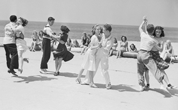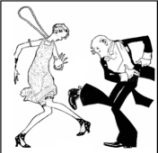Collegiate Shag
Collegiate Shag (not to be confused with Carolina Shag) is a dance that is thought to have evolved from the Charleston and originated in the South. It was popular in the 1920’s and 1930’s with college students. Collegiate Shag is normally danced to a six count basic step pattern. It may be danced in both closed and open position and is often danced to faster swing music.
Collegiate Shag basically consists of hopping type steps, instantly recognizable by the flicking of the feet backwards and sideways with a pronounced hopping action. Collegiate Shag was so  popular that in the late 1930’s even Arthur Murray began to teach a “toned down” and more “proper” version of Collegiate Shag.
popular that in the late 1930’s even Arthur Murray began to teach a “toned down” and more “proper” version of Collegiate Shag.
Collegiate Shag is a very aerobic and energetic dance that experienced a revival in popularity in the 1990’s and has a somewhat small, but enthusiastic, following with swing dancers today. If you’ve ever seen cartoons which show dancers pressing their faces and torsos together while their feet move fast underneath them, that’s the Collegiate Shag style of swing dance.
Check out the Collegiate Shag web site for more info on this dance.
The Charleston
The Charleston dance became established (worldwide) during the Ragtime-Jazz period. The series of steps are thought to have originated with African-Americans living on a small island near Charleston, South Carolina. The Charleston was performed as early as 1903 and made its way into Harlem stage productions by 1913. In 1923, it was introduced to the theater going public at the New Amsterdam Theater in New York, when the “Ziegfeld Follies” staged a dance that featured the Charleston. The dance was an immediate hit.
early as 1903 and made its way into Harlem stage productions by 1913. In 1923, it was introduced to the theater going public at the New Amsterdam Theater in New York, when the “Ziegfeld Follies” staged a dance that featured the Charleston. The dance was an immediate hit.
In the 1920’s, women who did the Charleston were called “Flappers” because of the way they would flap their arms and walk like birds while doing the Charleston. Many college students of the period, mostly men, wore raccoon coats and straw hats when doing the Charleston. Many saw the Charleston and Flappers as the downfall to many moral issues of the day. In 1925, Variety Magazine reported that in Boston, the vibrations of Charleston dancers were so strong that the dancers caused the “Pickwick Club” (a dance hall) to collapse, killing fifty people. In many dance halls, signs were posted that stated “PCQ” (Please Charleston Quietly).
By 1926, the Charleston had been replaced by other popular dances of the day. Charleston-style dance patterns and steps (often called Lindy Charleston) are very popular today with Lindy Hoppers.
Styles of Swing Dance Taught by Mike & Mary
Mike & Mary provide instruction primarily in the original swing dances of the 1930’s and 40’s: Lindy Hop and Balboa. We sometimes teach 1920’s Charleston and Collegiate Shag material. Click here for info on our current class offerings and info on private lessons.
One general piece of advice: learn the original swing dances! In swing dancing, you can’t separate the dance from the music. Learning and becoming proficient at Lindy Hop and Balboa will help you connect to the music and gain a much greater appreciation for the dance itself.
Yes, it’s true, at a lot of swing dances, the pre-dance lesson is often a “step, step, rock step” type of lesson. But that lesson is designed to get those up on the dance floor that have never danced before or that have very little dance experience. So as you progress, don’t settle for anything less than the original swing dances: Lindy Hop and Balboa!
A couple of quick notes:
(1) Although we teach the original 1930’s/40’s styles of swing dancing, we also believe in adapting and developing swing dancing (within the framework of the original dances and music). After all, improvisation, creativity and innovation are the hallmarks of American dancing!
(2) Any attempt to define the exact development of a particular style of dance or music (or indeed, of any art form) is an inexact science. It is important to keep in mind that swing dancing and swing music, like any artistic genre, represent the sum of many parts. Swing reflects the culmination of many different factors, influences and mutations. The development of swing dancing certainly includes geographical developments and distinctions that occurred in parallel and concurrently. The historical information on this web page is based on a variety of readings, research and experience.
Other Swing Dance Styles
The Hepcats only teach the original, authentic swing dances of the 1930’s/40’s. We sometimes get questions about other styles of dance, such as Ballroom Swing (East Coast Swing) and West Coast Swing. If you have questions about those styles, contact Mike and he can provide you info.